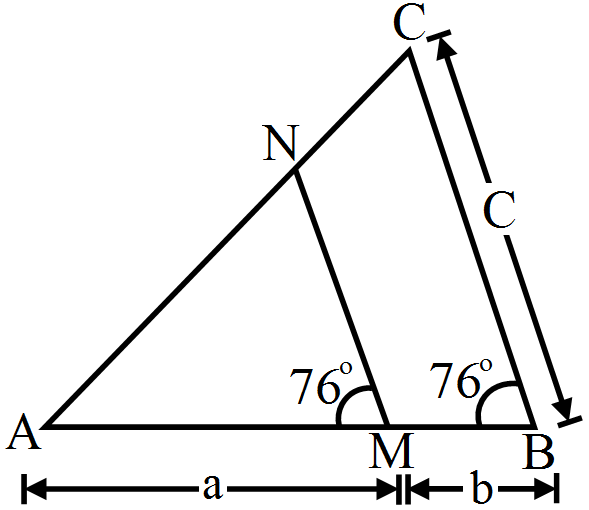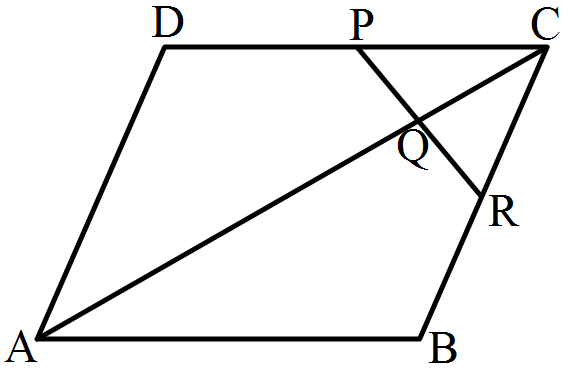For the following statments state whether true (T) or false(F):
The ratio of the areas of two similar triangles is equal to the ratio of their corresponding angle-bisector segments.
The ratio of the areas of two similar triangles is equal to the ratio of their corresponding angle-bisector segments.
True.
Solution:

Given that $\triangle\text{ABC}\sim\triangle\text{DEF}$ in which AX and DY are the bisectors of $\angle\text{A}$ and $\angle\text{D}$ respectively.
To prove: $\frac{\text{ar}(\triangle\text{ABC})}{\text{ar}(\triangle\text{DEF})}=\frac{\text{AX}^2}{\text{DY}^2}$
We know that,
The ratio of the areas of two similar triangles is equal to the ratio of the squares of the squares of the squares of the corresponding sides.
$\therefore\frac{\text{ar}(\triangle\text{ABC})}{\text{ar}(\triangle\text{DEF})}=\frac{\text{AB}^2}{\text{DE}^2}\dots\text{(i)}$
$\triangle\text{ABC}\sim\triangle\text{DEF}$
$\Rightarrow\angle\text{A}=\angle\text{D}$
$\Rightarrow\frac{1}{2}\angle\text{A}=\frac{1}{2}\angle\text{D}$
$\Rightarrow\angle\text{BAX}=\frac{1}{2}\angle\text{EDY}$
In $\triangle\text{ABX}$ and $\triangle\text{DEY},$
$\angle\text{BAX}=\angle\text{EDY}$ and $\angle\text{B}=\angle\text{E}$
So, by the AA criterion for similarity,
$\triangle\text{ABX}\sim\triangle\text{DEY}$
$\Rightarrow\frac{\text{AB}}{\text{DE}}=\frac{\text{AX}}{\text{DY}}$
$\Rightarrow\frac{\text{AB}^2}{\text{DE}^2}=\frac{\text{AX}^2}{\text{DY}^2}\dots(\text{ii})$
From (i) and (ii),
$\frac{\text{ar}(\triangle\text{ABC})}{\text{ar}(\triangle\text{DEF})}=\frac{\text{AX}^2}{\text{DY}^2}$
Solution:

Given that $\triangle\text{ABC}\sim\triangle\text{DEF}$ in which AX and DY are the bisectors of $\angle\text{A}$ and $\angle\text{D}$ respectively.
To prove: $\frac{\text{ar}(\triangle\text{ABC})}{\text{ar}(\triangle\text{DEF})}=\frac{\text{AX}^2}{\text{DY}^2}$
We know that,
The ratio of the areas of two similar triangles is equal to the ratio of the squares of the squares of the squares of the corresponding sides.
$\therefore\frac{\text{ar}(\triangle\text{ABC})}{\text{ar}(\triangle\text{DEF})}=\frac{\text{AB}^2}{\text{DE}^2}\dots\text{(i)}$
$\triangle\text{ABC}\sim\triangle\text{DEF}$
$\Rightarrow\angle\text{A}=\angle\text{D}$
$\Rightarrow\frac{1}{2}\angle\text{A}=\frac{1}{2}\angle\text{D}$
$\Rightarrow\angle\text{BAX}=\frac{1}{2}\angle\text{EDY}$
In $\triangle\text{ABX}$ and $\triangle\text{DEY},$
$\angle\text{BAX}=\angle\text{EDY}$ and $\angle\text{B}=\angle\text{E}$
So, by the AA criterion for similarity,
$\triangle\text{ABX}\sim\triangle\text{DEY}$
$\Rightarrow\frac{\text{AB}}{\text{DE}}=\frac{\text{AX}}{\text{DY}}$
$\Rightarrow\frac{\text{AB}^2}{\text{DE}^2}=\frac{\text{AX}^2}{\text{DY}^2}\dots(\text{ii})$
From (i) and (ii),
$\frac{\text{ar}(\triangle\text{ABC})}{\text{ar}(\triangle\text{DEF})}=\frac{\text{AX}^2}{\text{DY}^2}$
Download our appand get started for free
Experience the future of education. Simply download our apps or reach out to us for more information. Let's shape the future of learning together!No signup needed.*
Similar Questions
- 1$\triangle\text{ABC}\sim\triangle\text{DEF}$ such that $\text{ar}(\triangle\text{ABC})=64\text{cm}^2$ and $\text{ar}(\triangle\text{DEF})=169\text{cm}^2.$ If BC = 4cm, find EF.View Solution
- 2An aeroplane leaves an airport and flies due north at a speed of $1000\ km$ per hour. At the same time, aeroplane leaves the same airport and flies due west at a speed of $1200\ km$ per hour. How far apart will be the two planes after $1\frac{1}{2}\text{hour}?$View Solution
- 3In the given figure, D is the midpoint of side BC and $\text{AE}\perp\text{BC}.$ If BC = a, AC = b, AB = c, ED = x, AD = p and AE = h, prove that.View Solution

$(\text{b}^2-\text{c}^2)=2\text{ax}$ - 4$\triangle\text{ABC}\sim\triangle\text{PQR}$ and $\text{ar}(\triangle\text{ABC})=4\text{ar}(\triangle\text{PQR}).$ If BC 12cm, find QR.View Solution
- 5A man goes $10\ m$ due south and then $24\ m$ due west. How far is he from the starting point?View Solution
- 6The corresponding sides of two similar triangles ABC and DEF are BC = 9.1cm and EF = 6.5cm. If the rerimeter of $\triangle\text{DEF}$ is 25cm, find the perimeter of $\triangle\text{ABC}.$View Solution
- 7View SolutionFind the height of an equilateral triangle of side 12cm.
- 8In the given figure, $\angle\text{AMN}=\angle\text{MBC}=76^\circ.$ If p, q and r are the lengths of AM, MB and BC respectively then express the length of MN in terms of p, q and r.View Solution

- 9View SolutionThe corresponding altitudes of two similar triangles are 6cm and 9cm respectively, Find the ratio of their areas.
- 10ABCD is a parallelogram in which P is the midpoint of DC and Q is a point on AC such that $\text{CQ}=\frac{1}{4}\text{AC}.$ If PQ produced meets BC at R, prove that R is the midpoint of BC.View Solution

